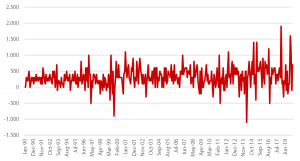Blog Post
Insight: As National Health Care Hiring Continues to Slide, Where Does Utah Stand?
By: Laura Summers
Health care is one of the nation’s strongest employment sectors. In recent months, however, national headlines pointing to a significant slowing of new jobs in recent months have the industry speculating whether the health care employment boom is coming to an end.[i] Data from the Bureau of Labor Statistics show declining rates of employment in both April and May 2019 that haven’t been seen since mid-2017.
So what does that mean for Utah? Data from the Kem C. Gardner Policy Institute’s April 2019 Economic Summary show that Education and Health Services account for 7.4 percent of Utah’s total gross domestic product and 13.5 percent of the state’s total employment. As a result, changes in both state and national-level health care employment have an impact on a large part of Utah’s working-age population.
Changes in Utah’s health sector employment generally mirror national trends. However, one key difference is a decline in Utah jobs following an early 2018 employment boom. Another difference is that preliminary April 2019 data show the potential for a corrective trend following a loss of jobs in March.
Health Care and Social Assistance Employment
Change in seasonally adjusted total from previous month

Note: April 2019 data is preliminary. Numbers are rounded to nearest 1,000.
Source: Bureau of Labor Statistics
Like the rest of the country, health sector hiring in Utah was strong in late 2017 and early 2018. Utah added 1,900 new health care and social assistance jobs in January 2018. This was an all-time high for the state and a peak that tracked what the nation experienced six months earlier. While the rest of the country continued to see upward trending growth through 2018, Utah’s health sector only saw moderate increases and some actual declines over the next year.
This trend reversed in January and February 2019, when Utah’s health sector added 1,600 and 1,200 jobs to its economy (respectively). While not as high as Utah’s 2018 hiring peak, these numbers reflect significant growth in health care employment that was also seen at the national level in December 2018. In March 2019, the U.S. experienced a new all-time high in health care hiring, with 49,900 new jobs added the economy. Unfortunately, Utah data show a loss of about 100 jobs during this same period. Preliminary numbers for April are promising, however, with positive growth of about 700 jobs in the state.
While it’s too early to know whether Utah’s May numbers will keep pace with the positive April trend or follow the national decline, there is no question that health care will continue to remain an important part of Utah’s economy. Health care and social assistance related jobs in Utah have grown over 200% since 1990.
To understand the nuances of this growth, further analysis should be completed on whether it is keeping pace with current and future population needs. Ensuring that the state is focused on hiring the right workforce to meet these changing needs will help it maintain its ranking as one of the healthiest states in the country. A growing senior population, changing health care needs, more focus placed on addressing social determinants of health, and increasing demand for mental health and substance use disorder services will all shape how Utah’s future workforce develops.
Laura Summers is a senior health care analyst at the Kem C. Gardner Policy Institute.
[i] Bannow, T. (2019, June 7). Healthcare hiring continued to slide in May. Modern Healthcare. Available from https://www.modernhealthcare.com/providers/healthcare-hiring-continued-slide-may?utm_source=modern-healthcare-am&utm_medium=email&utm_campaign=20190610&utm_content=article6-headline.

